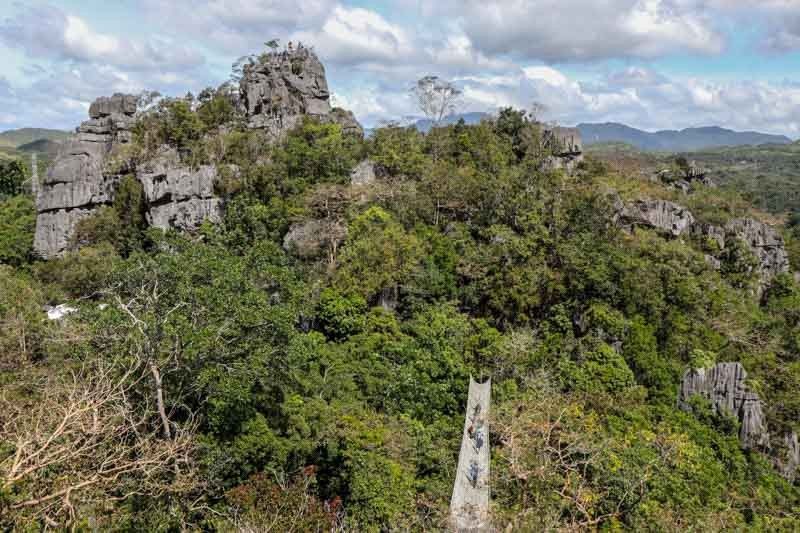Conservation initiative helps nature heal itself for Sierra Madre reforestation

Part 2 of a feature on reforestation efforts in the Sierra Madre.
Read Part 1, on an upland farmers' association working to green a former kaingin area, here.
RIZAL, Philippines — When he is not guiding visitors through the nature sanctuary, park ranger Ernie Belmonte nurtures trees planted in a patch of land in Rizal, a province east of Metro Manila.
First, Belmonte gets rid of stubborn weeds surrounding delicate saplings. He then digs a shallow ring around the plant — carefully, to spare its roots — and loosens the hard soil to make it easier for water to seep through.
For the final step, he stacks the weeds on top of the soil to keep moisture in and to shield the plant from extreme heat.
“What we’re doing is a small step in a larger initiative to restore the denuded land,” the 36-year-old park ranger says.
Planting trees is easy. Keeping the seedlings alive for them to grow is the challenge for Ernie Belmonte and other forest rangers at the Masungi Georeserve Foundation.
In 2017, the national government enlisted the organization’s help to restore and rewild some 2,700 hectares of heavily degraded lands in Baras town.
The project, called Masungi Geopark, has led to the planting of 60,000 native trees and has primed some 1,700 hectares for reforestation so far.
“The number of trees is not the main objective. It’s really bringing back an entire ecosystem of wildlife, water sources and biodiversity,” Billie Dumaliang, trustee and advocacy officer of Masungi, says.
Bringing back forests
.jpg)
Bringing back forests is a familiar task for the people behind the foundation. It manages the Masungi Georeserve, an award-winning conservation area known for its lush tropical scenery and sprawling karst landscape.
For a first-time visitor, it is hard to believe that what is now the Masungi Georeserve was once an abused strip of land. It now boasts of dense greenery and is home to more than 400 species of flora and fauna.
The conservation project began in 1996 as a partnership between the Department of Natural Resources and Blue Star Construction and Development Corp. Since then, the firm has initiated major restoration efforts in a 430-hectare area degraded by real estate speculation, quarrying and illegal logging.
Masungi Georeserve opened its doors to the public in 2016 as a “low-volume” ecotourism site. Fees paid by visitors are used to finance its conservation initiatives.
A year after opening the georeserve to the public, the organization entered into an agreement with the government to restore the land around the Masungi limestone formations, the original site of the project.
Some 100 park rangers, mostly from the nearby upland communities, help conserve wildlife species and the 60-million-year-old limestone formations, and protect the sanctuary from threats.
Letting nature heal
.jpg)
Masungi uses the forest rejuvenation method known as assisted natural regeneration (ANR), which relies on the natural ability of species to grow in an area.
The approach is centered on the idea that nature can come back to life when it is undisturbed, which means removing or reducing barriers to natural succession such as grazing and slash-and-burn is essential to the planting and nurturing of native trees.
According to the Food and Agriculture Organization, ANR is a low-cost restoration method as expenses associated with seedling production, site preparation and planting are greatly reduced.
But while it works for Masungi, the strategy may not work for other open areas in the country or those that are heavily denuded, Priscila Dolom, director of the Forest Development Center at the University of the Philippines - Los Baños said.
She added that “it will take time” before a forest is restored using ANR — more time than typical reforestation because it uses tree species such as narra and yakal instead of faster growing species.
“It took us 20 years to restore the original site into a thriving forest. Hopefully, with accelerated growth by native tree planting and interventions against encroachment, we could see a restored forest in 10 years or so,” Dumaliang said.
The Forest Management Bureau said there is no one approach to reforestation, especially in the Philippines. Hence, prescribing ANR as the default reforestation strategy is “not sound.”
The Forest Foundation Philippines agreed, saying “the pursuit of this generalization has led to the planting of inappropriate species, deployment of inappropriate methods, and engagement of inappropriate groups.”
Saving Sierra Madre, watersheds
.jpg)
There were renewed calls to protect the Sierra Madre, the longest mountain range in the country which spans from the northern province of Cagayan down to Quezon in southern Luzon, following back-to-back typhoons late last year.
Protecting the Sierra Madre is critical because it is the site of nearly half of the surviving old-growth forest in the Philippines. The mountain range also historically serves as a buffer against storms that develop in the Pacific Ocean, protecting millions of Filipinos living in the main island of Luzon.
Despite many laws and regulations aimed at preserving the remaining forests, the Sierra Madre remains under heavy threat of illegal logging, mining activities and development projects
The inability of watersheds to absorb and hold rainfall contributed to the severe flooding that submerged communities in Marikina City and Rizal following the onslaught of Typhoon Ulysses (Vamco) late last year.
Masungi, located on the foothills of the Sierra Madre, is part of the 26,000-hectare Upper Marikina River Basin Protected Landscape and is located near the Kaliwa Watershed Forest Reserve, the site of a controversial dam project.
The new forest is seen to help prevent landslides and flooding events by restoring the natural ability of watersheds to regulate water for upland communities and lowland cities.
“We need to realize that nature’s health and people’s health are strongly intertwined. The current pandemic as well as the floodings from Typhoon Ulysses and Rolly [Goni], are stark reminders of what will continue to happen if we don’t make radical changes to the way we have been treating our forests and watersheds,” Dumaliang said.
Battles to defend the reserve
.jpg)
In 1993, the DENR issued an administrative order declaring Masungi a strict nature reserve and wildlife sanctuary and making it off limits to exploitative activities that might adversely affect the ecological balance in the area.
The inundation of communities brought by Tropical Storm Ondoy (Ketsana) in 2009 prompted a declaration upgrading the status of the Marikina watershed to a protected area.
Despite these, the Masungi foundation still struggles to defend its project.
Dumaliang said 1,500 hectares of the site have since been covered by Mineral Production Sharing Agreements, which give contractors the right to mine within the area.
In March 2020, a quarry company fenced off some 500 hectares of the reforestation site to block the access of Masungi personnel. In October of the same year, they faced the same threat; this time from a meat distributor that also owns a renewable energy company.
Rublou Inc. claimed the area it fenced off is part of the ancestral domain of the indigenous Dumagat-Remontados, not of the Masungi Geopark. Dumaliang said they met with the community’s council of elders, who denied involvement in the actions.
"After a while, several alleged members appear to have backtracked on this statement, apparently without the knowledge and consent of the elders and the rest of the [community]," she says.
After learning that an estimated 500 hectares of the project site was included in the group’s application for ancestral domain title, Masungi said it would respect their rights in parts of the geopark covered by their ongoing application.
If declared as an ancestral domain, all development projects within the land will need the free and prior informed consent of the IP group before these can proceed.
Charcoal-making is also one of the illegal activities inside the watershed.
“It saddens us that young trees are cut down and turn into charcoal. It takes 20 years for a tree to grow but people only cut it down in an instant,” Belmonte said, as he pointed to charcoal pits, piles of logs and stumps that were left of the trees in an area that is only in the early stage of forest succession.
To protect the nature sanctuary, Dumaliang asked the government to cancel mining and quarrying permits inside the project site and provide them a “dedicated and courageous” counterpart from the environment department.
“In the context of the climate crisis, where Filipinos are some of the most vulnerable people, it is not just unsound, but highly immoral and maybe even criminal to sacrifice nature’s conservation in favor of short-term and destructive interests,” she said.
Expanding initiatives
.jpg)
The organization aims to make its reforestation initiatives “as big as possible.”
“It’s important to continuously expand the conservation area. We should do more because these are contiguous areas and they try to support a wide variety of species, plants, animals, an entire ecosystem,” Dumaliang said.
For Belmonte, his experience with Typhoon Reming (Durian) in 2006 that wreaked havoc in his hometown in the Bicol region made him realize the critical role that trees play during disasters.
Knowing this and the importance of the area he is protecting within and beyond Rizal motivates him to take care of trees and the lands where they belong.
“We’re protecting the land not only for beautification purposes but for the sake of the next generation,” he said.
The story is part of the Climate Tracker's Southeast Asia Forest Recovery Collaborative Journalism project, produced with support from the Rainforest Journalism Fund in partnership with the Pulitzer Center.
- Latest
- Trending






























